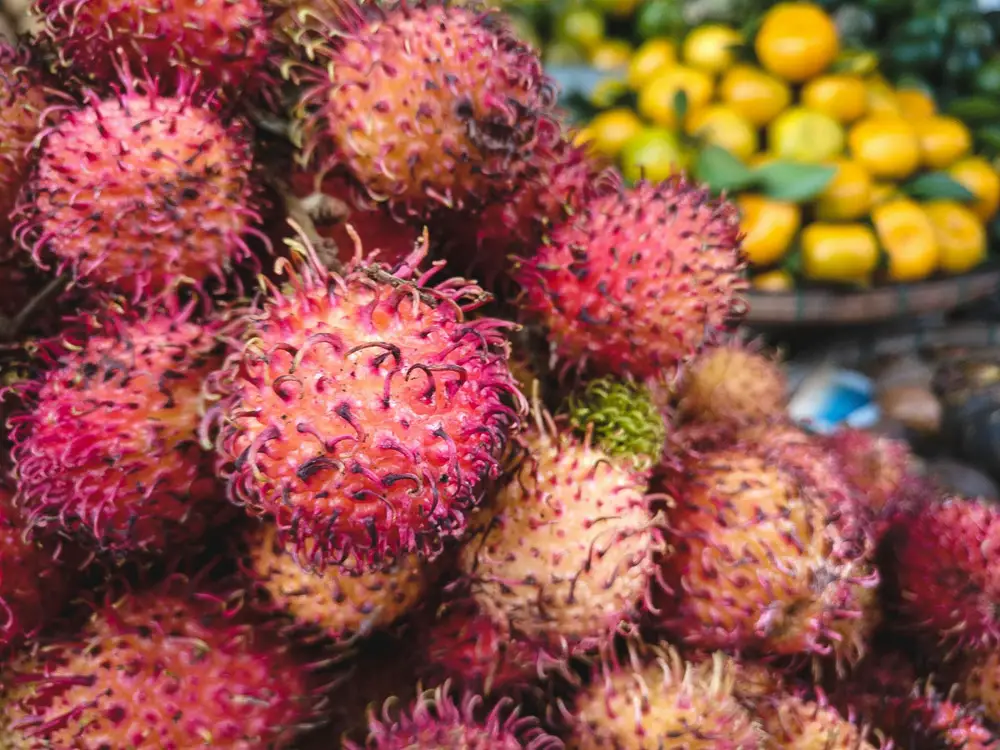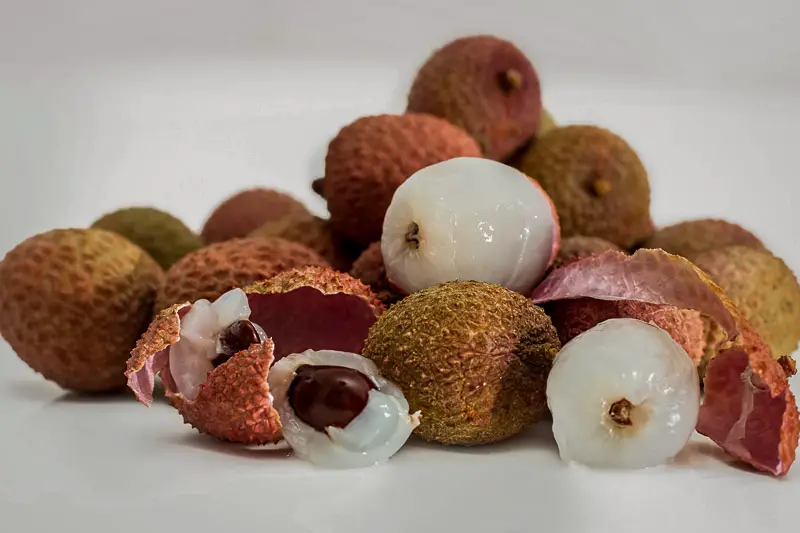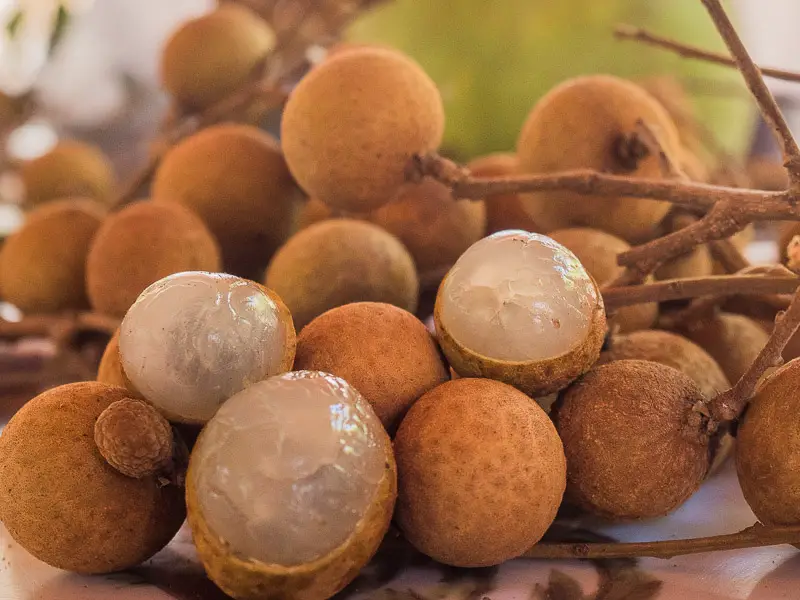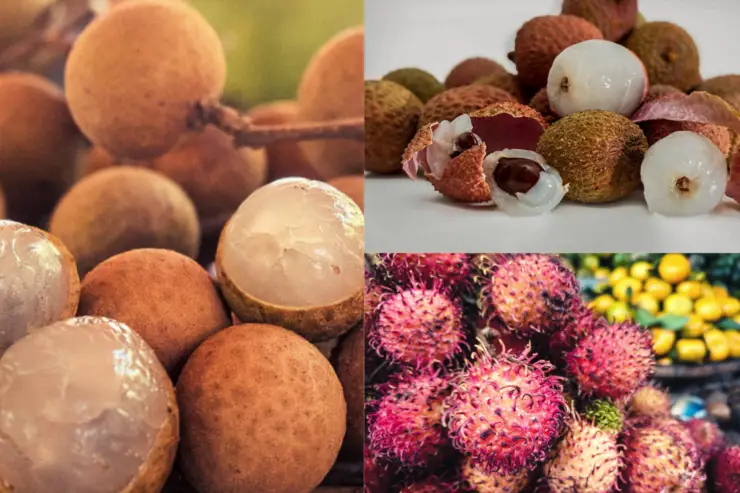As an Amazon Associate I earn from qualifying purchases. Please read the disclaimer for more info.
Rambutan vs Lychee vs Longan
The Rambutan vs Lychee vs Longan conundrum? When I first started visiting Southeast Asia back in the 1990’s – yes, a long time ago now, trying to navigate the endless stalls of fresh and exotic fruits, many I’d never seen before, was a tricky, fun, and usually a very messy experience.
There was one set of tropical fruits that were harder to distinguish between than others, because they all looked similar to each other. And what made the rambutan vs lychee vs longan conundrum more difficult, was that each fruit had its own harvesting timeframe, meaning it was hard to line them all up against each other at once.
Now that I’m based in Vietnam, the task is somewhat easier these days, but for first time visitors to this country, or to the wider Southeast Asian region, the similarities and differences between rambutan, lychee, and longan may not be as obvious.
So, what exactly are these fruits and how are they similar or different from the other?

Brief History of the Three Delicious Fruits
The rambutan, which is the largest of the three fruits, is thought to be native to Malaysia, with the name – rambutan – being from the Malay language. Rambut literally means “hair”, which comes from the protruding hair-like prongs that stick out from the rambutan’s skin. The popular rambutan fruit is now grown widely in Southeast Asia, as well as in Central America.
The lychee is native to the southern regions of China, and is believed to have been grown for over 2,000 years. These days, the Chinese province of Guangdong is known as the “Kingdom of the Lychee”, due to the quality and sheer volume of fresh lychees production. Lychee production has now spread to most subtropical regions of the world and can be found in countries as disparate as Australia, France, and North America.
The history of the longan is less clear cut with some thoughts that it originated in the mountains that lie between Myanmar and China, although it is recognised that the fruit originated somewhere within the wider region. The name of the fruit comes from the cantonese name for dragon eye (lùhng-ngáahn), coming from the way the fruit looks once the shell is removed, with the black seed being seen through the white translucent flesh.

Similarities – Rambutan vs Lychee vs Longan
The rambutan, lychee, and longan are known for the white colour of their flesh, with each fruit having an inedible dark-coloured seed that lies in the middle.
All three fruits grow on trees and can be eaten straight off the branch, but also from a can as the flesh is also available in cans as a packaged good. Regardless, they are delicious in fruit salads.
All contain a number of health benefits including vitamin C.
And I’ve read that although by themselves, each fruit has its own unique taste, this disparity in flavour is removed when mixed in an alcoholic drink – lychee martini anyone? I will do more research in this area.

Differences – Rambutan vs Lychee vs Longan
Although the rambutan, lychee, and longan fruits have their similarities, there are quite a few distinct, and subtle, differences between them.
The rambutan is the largest of the 3 fruits, usually being the size of a golf ball. The key distinguishing feature of the rambutan is the hair-like prongs that stick out from the shell. These “hairs” can come in different colors and I’ve seen red (mostly), yellow, and bright green.
The color of the shell is usually red, however, it can have tinges of yellow as well.
The rambutan’s white flesh is flowery, sweet, and has a creamy texture.
Lychees are smaller in size than the rambutan but have a similar red tinge to the shell, which is rougher to the touch than the other two fruits. The obvious difference is the lack of “hairs” protruding from the rough shell.
The white flesh of the fresh lychee, although similar in looks to the rambutan, is not as sweet or creamy to the tongue, with a crisper bite to the fruit’s flesh.
The lychee’s seed is significantly darker than the seed of the rambutan.
The longan fruit is the smallest in the bunch and has a distinct light brown coloration. The skin is the most brittle, and once removed, the sight of the flesh and seed gives the impression of an “eye”. This has led to the longan fruit also being known as Dragon Eye Fruit.
Possessing a stronger flavour, the longan is more tart than the other fruits.
Summary
These 3 tropical fruits are all delicious with the main differences relating to their look, levels of sweetness, and ability to open the skin and get access to the delightful flavors.
Hopefully, that helps you understand the rambutan vs lychee vs longan comparison a little more.
Rambutan trees can reach an impressive 25 meters tall.


Excellent. I had this question in my mind for a long time. I tried all these 3 fruits several times. Similarities. Differences and tastes are exactly the same as you described. Thank you so much.